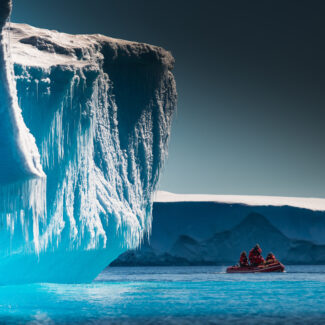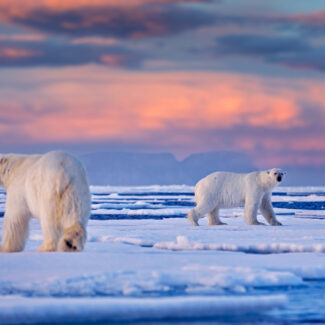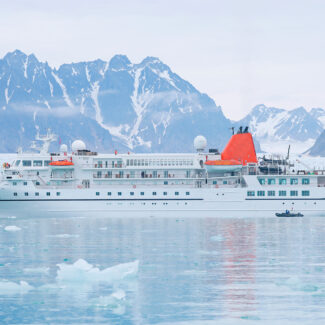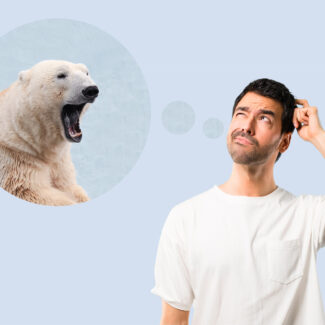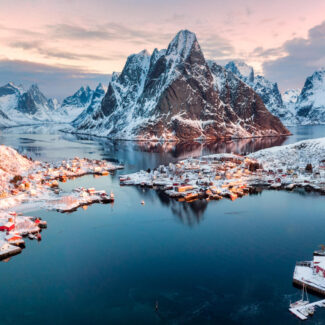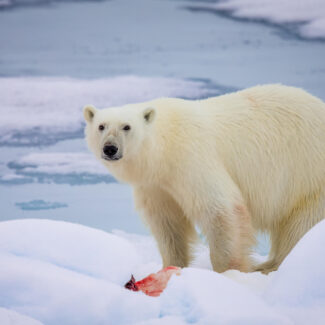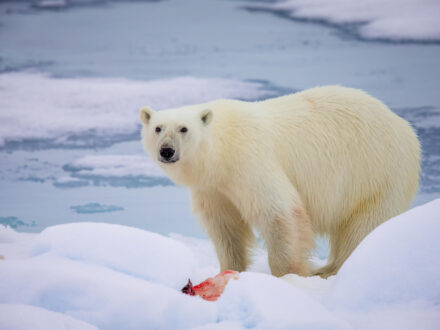Antarctica Animals & Wildlife: List & Visitor's Guide
- Antarctica Animals: A Few Superlatives to Start Off With
- Adaptations of Animals in Antarctica
- Marine Life of the Antarctic
- Antarctic Flying Birds
- Freshwater Animal Life in the Antarctic
- Terrestrial Animal Life in the Antarctic
- Where Antarctic Wildlife Lives
- Prehistoric Animals of Antarctica
- Recently Extinct Animals From Antarctica & the Sub-Antarctic
- Plants of Antarctica
- Where to See Animals in Antarctica
- Antarctica Wildlife List: Birds & Mammals
Antarctica might seem to present a highly forbidding habitat for animals—and, indeed, it does, when it comes to the landmass of the frozen continent itself. Yet the ocean that surrounds it is epically bountiful and, at least seasonally and in places, throbbing with life.
That thronged life extends to narrow coastal margins of Antarctica as well as the shores of Antarctic and sub-Antarctic islands, which together present some of the finest wildlife-watching in the world.
Antarctica Animals: A Few Superlatives to Start Off With
The largest creature in the Antarctic is the blue whale, which also happens to be the biggest animal to have ever existed. Indeed, Antarctic blue whales appear to be the largest of their (large) kind, likely reaching nearly 100 feet long and weighing 200 or more tons.
The blue whale is only the heftiest of a slew of very big marine animals in Antarctica. Yet when it comes to the largest truly terrestrial animal on the White Continent, we’re way, way down at the other end of the size spectrum: It’s the Antarctic midge, reaching only about four to six millimeters maximum in length.
In terms of the largest critter in Antarctic skies, the frozen continent’s coast is part of the vast range of the largest flying bird in the world as measured by wingspan: the wandering albatross, which may span a dozen feet from wingtip to wingtip. (The wandering albatross may be the biggest flying bird in Antarctica, but it’s substantially outweighed by the endemic—and flightless—emperor penguin, which may tip the scales at about 100 pounds.)
Prepare to be amazed by the incredible superlatives of Antarctic wildlife! From the smallest krill to the largest creature on Earth, the blue whale, the waters here teem with life. Imagine seeing a magnificent whale like this swimming beneath a colossal iceberg—it’s just one of the many awe-inspiring encounters awaiting you in Antarctica.
Adaptations of Animals in Antarctica
Wildlife demonstrates numerous different adaptations for contending with the extremes of the Antarctic environment—and capitalizing on its richness. Most obviously, critters down here need to deal with big-time cold. Many do so at least partly by migrating away during the long, ice-bound winter months. (To take one extreme example, the Arctic tern spends the austral summer down in the Antarctic, then migrates all the way to the other side of the world to enjoy the boreal summer in the Arctic.)
Thick layers of fatty blubber help insulate whales, seals, and penguins from chill polar waters (and also provide an energy source for weathering lean periods). Natural antifreeze molecules and compounds protect certain Antarctic fishes and invertebrates from frigid temperatures. And some creatures can actually freeze without suffering damage, as in the case of larval Antarctic midges.
Both penguins and the many species of “tube-nosed” seabirds in the Southern Ocean have modified nasal passageways for extruding salt, which allows them to drink seawater, most handy considering the lack of freshwater and precipitation in this part of the world.
Marine Life of the Antarctic
The Southern Ocean (sometimes also called the Antarctic Ocean) ranks among the most productive marine ecosystems on Earth. Its fertility is due to a variety of factors, including extensive nutrient-rich upwellings and the major photosynthetic boost resulting from the many hours of daily sunshine beaming down during the austral summer.
Invertebrates
A wide variety of invertebrates call Antarctica’s icy waters home, none so well known as the Antarctic krill, among the largest species of krill and inhabiting the Southern Ocean in a biomass of several hundred million tons. The great krill swarms result from the super-abundant phytoplankton food source, and in turn provide sustenance for a staggering number and diversity of predators: from fish and penguins to seals and baleen whales.
Krill aren’t the only important marine crustacean in the Southern Ocean. Copepods and amphipods also help constitute the zooplankton community. In more northerly parts of the ocean, a few deepwater crabs can be found, including the Antarctic king crab.
All kinds of other marine invertebrates also play roles in the Southern Ocean ecosystem, including such bottom-dwellers as sea cucumbers, brittle stars, sea spiders, and scale worms. Cephalopods, including a significant number of endemic kinds, are important as well: from octopods such as the Turquet’s octopus to a number of squid species, including the colossal squid, most massive of all invertebrates (and prized as prey by the deep-diving sperm whale).
At the very foundation of Antarctica’s astonishing food web lies the humble yet mighty krill. These tiny invertebrates, like the one pictured, are the lifeblood of the Southern Ocean, supporting everything from penguins and seals to the largest whales – a testament to the incredible marine ecosystem thriving beneath the icy surface!
Fish
More than 320 species of fish can be found in waters over Antarctica’s continental shelf and slope, though only a few taxonomic groups are represented: indicating the evolutionary bottleneck and resulting diversification/speciation that occurred as the severe polar environment of the Antarctic Southern Ocean developed.
Among the most important fish groups are the cod icefishes, the white-blooded fishes, and the dragonfishes. The cod icefishes include the largest Antarctic fish, the Patagonian and Antarctic toothfishes, which may exceed six feet long and 200 pounds in weight.
Penguins
No wildlife is more associated with Antarctica than penguins. Although there are 18 or so species of these flightless aquatic birds found worldwide (almost exclusively in the Southern Hemisphere), only seven are actually found in the Antarctic: the emperor, king, Adélie, rockhopper, gentoo, chinstrap, and macaroni penguins.
Of those, the king and rockhopper are sub-Antarctic in distribution; the other five reach mainland Antarctica, though only the emperor—the world’s biggest penguin—overwinters on the continent. (Given Antarctica isn’t a nation, there’s no official “national animal,” but the emperor penguin would probably be the top choice if there was.)
No visit to Antarctica is complete without encountering its most iconic residents: penguins! From the playful Gentoo chicks showing off, as seen here, to the vast colonies of various species, these charismatic birds are a constant source of joy and fascination, offering endless opportunities for unforgettable wildlife-watching experiences.
Marine Mammals
The Antarctic supports a rich diversity of marine mammals, another reflection of the Southern Ocean’s great productivity. Six species of pinnipeds can be found in Antarctic waters proper, from the gigantic southern elephant seal (mainly found in sub-Antarctic islands and foraging along the continental margin) and toothy leopard seal to the crabeater seal, reckoned as perhaps the most abundant large wild mammal in the world. Those are all “true” or earless seals; an eared seal more closely allied with sea lions, the Antarctic fur seal, is also found here, with a couple of other fur-seal species reaching sub-Antarctic islands.
Antarctic waters are also a major haven for cetaceans: whales and dolphins. The roster includes six species of baleen whales (primarily scarfing krill here) as well as such toothed whales as the sperm whale, the orca (aka killer whale), and the hourglass dolphin.
Antarctic Flying Birds
Penguins may be the most emblematic of Antarctica’s birds, but their flying counterparts are just as significant to the overall ecosystem. A wide variety of tube-nosed seabirds of the avian order Procellariiformes tap the bountiful resources of the Southern Ocean. They include the wandering and numerous other albatross species as well as prions (whalebirds), fulmars, diving petrels, skuas, giant petrels, Antarctic petrels, shearwaters, and more.
Other Antarctic seabirds include the kelp gull, the Arctic and Antarctic terns, and the various blue-eyed shags or cormorants. Then there’s the only line of truly endemic Antarctic/sub-Antarctic birds, the rather strange sheathbills, plus a couple of ducks found on South Georgia and the one species of Antarctic songbird: the South Georgia pipit.
While penguins often steal the show, Antarctica’s skies are home to a fascinating array of flying birds, including formidable predators like the South Polar Skua. Keep an eye out for these impressive aviators soaring overhead, adding another layer of wonder to the continent’s diverse wildlife tapestry.
Freshwater Animal Life in the Antarctic
From permanently or seasonally frozen surface lakes to sub-ice pools and rivers, Antarctica’s enigmatic and little-known freshwater bodies support their own specialized roster of invertebrate life, including fairy shrimp, water fleas, copepods, amphipods, and tardigrades (the so-called “water bears”).
Terrestrial Animal Life in the Antarctic
In Antarctica, genuinely terrestrial animal life—so not counting the various vertebrates that utilize limited parts of the Antarctic continent while fueling themselves from the marine ecosystem, such as penguins and seals—is restricted to a handful of invertebrates.
Remarkably, only a few insect species are found in the Antarctic, and but one—the aforementioned Antarctic midge—inhabits the White Continent itself. This flightless midge lives by far the majority of its two-year life cycle as larvae that remain frozen for some eight or nine months of the year, thawing out to feed in the summertime. These larvae eventually transform into adult midges that, lacking mouthparts, don’t feed or drink; they simply seek out mates and, in the case of females, lay eggs before dying within about two weeks.
There are also other invertebrates, perhaps the most abundant and significant of which are soil-based nematodes (“roundworms”) that can even withstand the harsh conditions of such frigid, snow-free continental zones as the McMurdo Dry Valleys.
Where Antarctic Wildlife Lives
We have to give plenty of “props” to those tiny, hardy critters that manage to survive in such extreme Antarctic zones as subglacial lakes and bareground soil in continental oases free of permanent snow or ice cover. The most visible Antarctic wildlife, however, is, unsurprisingly, found in the waters and islands of the Southern Ocean and along the comparatively mild coast of the Antarctic Peninsula.
Only the marine realm, vastly more productive than Antarctica’s terrestrial ecosystem, can support animals larger than midges and roundworms. So it’s the offshore and maritime-influenced coastal zone where the greatest hubbub of animal life takes place south of the Polar Front.
Do any animals actually live at the South Pole proper? That geographic extreme on the Antarctic Polar Plateau presents an inhospitable ice-sheet environment, and animals are mostly absent. That said, a few species of hardy seabird have been seen winging over the South Pole, including the south polar skua and the snow petrel.
Antarctica’s wildlife thrives in specific, often dramatic, habitats. Locations like South Georgia Island, depicted here with its colossal King penguin colonies and misty mountain backdrops, are prime examples of where you can witness the sheer abundance of Antarctic life, showcasing the unique ecosystems that support these incredible creatures.
Prehistoric Animals of Antarctica
Antarctica wasn’t always a forbidding, frozen-over emptiness. Going back tens of millions of years, before the separation of Gondwana and the development of the Antarctic Circumpolar Current and Polar Front helped isolate the White Continent as a polar ice sheet, temperate and even semitropical forests flourished, and a much more diverse roster of terrestrial life tromped around. We’re talking everything from dinosaurs to marsupials and ungulates.
Needless to say, there’s a pretty fascinating prehistoric zoo petrified in the Antarctic fossil record. Learn more about animal fossils found in Antarctica here.
Recently Extinct Animals From Antarctica & the Sub-Antarctic
Although the Antarctic in general has suffered less widespread ecological destruction than more temperate and accessible parts of the world, its roster of extinct species isn’t restricted to the prehistoric menagerie.
The sub-Antarctic Falkland Islands once played host to their own native wild canine: the Falkland Islands wolf, also called the warrah. This foxlike beast inhabited the most isolated landmass of any canid, but was killed off by humans during the 1870s. Its ancestors probably colonized the farflung Falklands during the last ice age, when vastly lowered sea levels meant a relatively brief swim across a shallow strait—which perhaps seasonally froze over, allowing for a trot across—facilitated access.
Plants of Antarctica
The extensiveness of Antarctica’s ice cover, plus all of the other elements of its fierce climate, pose major challenges to plantlife as well as animal life. Some species do prosper here, from mosses and liverworts to a couple of hardy flowering plants native to the Antarctic Peninsula. Learn more about the botanical side of the White Continent here.
Where to See Animals in Antarctica
As alluded to above, the most productive Antarctic wildlife-watching from a human sightseer’s standpoint goes down on the islands of the Southern Ocean and the Antarctic Peninsula. Sub-Antarctic and Antarctic islands such as South Georgia and the South Shetlands serve up remarkable seasonal spectacles of penguins, seabirds, and pinnipeds, as does the Antarctic Peninsula. Coastal waters throughout, not to mention pelagic traverses, offer the potential to see baleen whales and orcas in the late austral summer season.
Specialized cruises deeper into Antarctic seas such as the Weddell and the Ross pursue the emperor penguin in its remote colonies.
Getting this close to an incredible elephant seal is an unforgettable experience! While you can spot wildlife throughout your journey, specific landing sites and Zodiac cruises in areas like the Antarctic Peninsula and South Georgia are carefully chosen to maximize your opportunities for breathtaking animal encounters.
Antarctica Wildlife List: Birds & Mammals
The following is an attempt at a fairly exhaustive list of marine mammals and birds one could see on an Antarctic cruise. Keep in mind, though, that the Southern Ocean is vast and interconnected with the South Atlantic, Pacific, and Indian Ocean basins; both flying and swimming beasts from well north may occasionally drift into the sub-Antarctic zone. You never quite know what you might see from the ship deck!
MARINE MAMMALS
Cetaceans
- Humpback Whale (Megaptera novaeangliae)
- Blue Whale (Balaenoptera musculus)
- Fin Whale (Balaenoptera physalus)
- Sei Whale (Balaenoptera borealis)
- Antarctic Minke Whale (Balaenoptera bonaerensis)
- Southern Right Whale (Eubalaena australis)
- Sperm Whale (Physeter macrocephalus)
- Orca (Orcinus orca)
- Long-finned Pilot Whale (Globicephala melas)
- Hourglass Dolphin (Lagenorhynchus cruciger)
- Cuvier’s Beaked Whale (Ziphius cavirostris)
- Southern Bottlenose Whale (Hyperoodon planifrons)
Pinnipeds
- Southern Elephant Seal (Mirounga leonina)
- Leopard Seal (Hydrurga leptonyx)
- Ross Seal (Ommatophoca rossii)
- Weddell Seal (Leptonychotes weddellii)
- Crabeater Seal (Lobodon carcinophaga)
- Antarctic Fur Seal (Arctocephalus gazella)
- Subantarctic Fur Seal (Arctocephalus tropicalis)
- New Zealand Fur Seal (Arctocephalus forsteri)
BIRDS
- Emperor Penguin (Aptenodytes forsteri)
- King Penguin (Aptenodytes patagonicus)
- Adélie Penguin (Pygoscelis adeliae)
- Chinstrap Penguin (Pygoscelis antarcticus)
- Gentoo Penguin (Pygoscelis papua)
- Rockhopper Penguin (Eudyptes chrysocome)
- Macaroni Penguin (Eudyptes chrysolophus)
- Wandering Albatross (Diomedea exulans)
- Royal Albatross (Diomedea epomophora)
- Gray-headed Albatross (Thalassarche chrysostoma)
- Black-browed Albatross (Thalassarche melanophris)
- Light-mantled Albatross (Phoebetria palpebrata)
- Sooty Albatross (Phoebetria fusca)
- South Polar Skua (Stercorarius maccormicki)
- Brown Skua (Stercorarius antarctica)
- Antarctic Prion (Pachyptila desolata)
- Broad-billed Prion (Pachyptila vittata)
- Slender-billed Prion (Pachyptila belcheri)
- Fairy Prion (Pachyptila turtur)
- Fulmar Prion (Pachyptila crassirostris)
- Salvin’s Prion (Pachyptila salvini)
- Common Diving Petrel (Pelecanoides urinatrix)
- South Georgia Diving Petrel (Pelecanoides georgicus)
- Northern Giant Petrel (Macronectes halli)
- Southern Giant Petrel (Macronectes giganteus)
- Sooty Shearwater (Ardenna grisea)
- Short-tailed Shearwater (Ardenna tenuirostris)
- Antarctic Petrel (Thalassoica antarctica)
- Snow Petrel (Pagodroma nivea)
- White-chinned Petrel (Procellaria aequinoctialis)
- Gray petrel (Procellaria cinerea)
- Soft-plumaged Petrel (Pterodroma mollis)
- Mottled petrel (Pterodroma inexpectata)
- White-headed Petrel (Pterodroma lessonii)
- Kerguelen Petrel (Aphrodroma brevirostris)
- Southern Fulmar (Fulmarus glacialoides)
- Black-bellied Storm-petrel (Fregetta tropica)
- Wilson’s Storm-petrel (Oceanites oceanicus)
- Gray-backed Storm-petrel (Garrodia nereis)
- Antarctic Tern (Sterna vittata)
- Arctic Tern (Sterna paradisaea)
- Kelp Gull (Larus dominicanus)
- Antarctic Shag (Leucocarbo bransifieldensis)
- South Georgia Shag (Leucocarbo georgianus)
- Kerguelen Shag (Leucocarbo verrucosus)
- Macquarie Shag (Leucocarbo purpurascens)
- Crozet Shag (Leucocarbo melanogenis)
- Campbell Shag (Leucocarbo cambelli)
- Heard Island Shag (Leucocarbo nivalis)
- Black-faced Sheathbill (Chionis minor)
- Snowy Sheathbill (Chionis albus)
- South Georgia Pintail (Anas georgica)
- Yellow-billed Teal (Anas flavirostris)
- South Georgia Pipit (Anthus antarcticus)
Disclaimer
Our travel guides are for informational purposes only. While we aim to provide accurate and up-to-date information, Antarctica Cruises makes no representations as to the accuracy or completeness of any information in our guides or found by following any link on this site.
Antarctica Cruises cannot and will not accept responsibility for any omissions or inaccuracies, or for any consequences arising therefrom, including any losses, injuries, or damages resulting from the display or use of this information.


